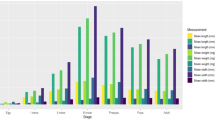Abstract
Thanatophilus micans is capable of finding corpses at least as quickly as most fly species and, as the most widespread species of the Silphidae in Africa, offers a useful model for estimating post-mortem interval. Larvae were reared at ten constant temperatures from 15°C to 35°C and their length measured at 4, 8, or 12-h intervals depending on their instar. Length generally increased with increased rearing temperature, but decreased at extremely high temperatures. Note was made of the age at which individuals progressed past developmental milestones. Development took longer at lower temperatures. These results are presented as a combined isomegalen and isomorphen diagram. Developmental constants were generated for each milestone using major axis regression. Developmental threshold values did not differ significantly between milestones. Development took longer than in blow flies, but was faster than in Dermestidae. The three models presented here, therefore, cover an important time frame in estimating minimum PMI once fly larvae have matured to the point of leaving a corpse, and, therefore, provide a tool that was not previously available to forensic entomologists.






Similar content being viewed by others
References
Amendt J, Campobasso CP, Gaudry E, Reiter C, LeBlanc H, Hall M (2007) Best practice in forensic entomology—standards and guidelines. Int J Leg Med 121:90–104
Byrd JH, Castner JL (2001) Insects of forensic importance. In: Byrd JH, Castner JL (eds) Forensic entomology: the utility of arthropods in legal investigations. CRC, Boca Raton, pp 43–80
Catts EP (1992) Problems in estimating the postmortem interval in death investigations. J Agr Entomol 9:245–255
Catts EP, Goff ML (1992) Forensic entomology in criminal investigations. Annu Rev Entomol 37:253–272
Coombs CW (1979) The effect of temperature and humidity upon the development and fecundity of Dermestes haemorrhoidalis (Kuster) and Dermestes peruvianus (Laporte de Castelnau) (Coleoptera: Dermestidae). J Stored Prod Res 15:43–52
Czypionka K, Hill MP (2007) The relationship between female pupal mass and fecundity of Gratiana spadicea (Klug, 1829) (Coleoptera: Chrysomelidae). Afr Entomol 15:380–382
Dadour IE, Cook DF, Fissioli JN, Bailey WJ (2001) Forensic entomology: application, education and research in Western Australia. Forensic Sci Int 120:48–52
Gaudry E, Myskowiak JB, Chauvet B, Pasquerault T, Lefebvre F, Malgorn Y (2001) Activity of the forensic entomology department of the French Gendarmerie. Forensic Sci Int 120:68–71
Grassberger M, Reiter C (2001) Effect of temperature on Lucilia sericata (Diptera: Calliphoridae) development with special reference to the isomegalen- and isomorphen-diagram. Forensic Sci Int 120:32–36
Grassberger M, Reiter C (2002) Effect of temperature on development of the forensically important holarctic blow fly Protophormia terraenovae (Robineau-Desvoidy) (Diptera: Calliphoridae). Forensic Sci Int 128:177–182
Higley LG, Haskell NH (2001) Insect development and forensic entomology. In: Byrd JH, Castner JL (eds) Forensic entomology: the utility of arthropods in legal investigations. CRC, Boca Raton, pp 287–302
Honêk A (1993) Intraspecific variation in body size and fecundity in insects: a general relationship. Oikos 66:483–492
Ikemoto T, Takai K (2001) A new linearized formula for the law of total effective temperature and the evaluation of line-fitting methods with both variables subject to error. Environ Entomol 29:671–682
Lambkin TA, Khatoon N (1990) Culture methods for Necrobia rufipes (Degeer) and Dermetes maculatus Degeer (Coleoptera: Cleridae and Dermestidae). J Stored Prod Res 26:59–60
Richards CS, Paterson ID, Villet MH (2008) Estimating the age of immature Chrysomya albiceps (Diptera: Calliphoridae), correcting for temperature and geographical latitude. Int J Legal Med 122:271–279
Richardson MS, Goff ML (2001) Effects of temperature and intraspecific interaction on the development of Dermestes maculatus (Coleoptera: Dermestidae). J Med Entomol 38:347–351
Schawaller W (1987) Faunistische und systematische Daten zur Silphiden-Fauna Sudafrikas (Coleoptera, Silphidae). Entomofauna 8:277–288
Smith KGV (1986) A manual of forensic entomology. British Museum (Natural History), London, p 205
Villet MH (2007) An inexpensive geometrical micrometer for measuring small, live insects quickly without harming them. Entomol Exp Appl 122:279–280
Villet MH, MacKenzie B, Muller WJ (2006) Larval development of the carrion-breeding flesh fly, Sarcophaga (Liosarcophaga) tibialis Maquart (Diptera: Sarcophagidae), at constant temperatures. Afr Entomol 14:357–366
Archer MS, Elgar MA, Briggs CA, Ranson DL (2006) Fly pupae and puparia as potential contaminants of forensic entomology samples from sites of body discovery. Int J Legal Med 120:364–368
Day DM, Wallman JF (2006) A comparison of frozen/thawed and fresh food substrates in development of Calliphora augur (Diptera: Calliphoridae) larvae. Int J Legal Med 120:391–394
Acknowledgments
We thank Sue Abraham for her assistance in creating the isomegalen/isomorphen diagram; Terence Bellingan, Cameron Richards and Kendall Crous for assistance in the laboratory and Rhodes University and the National Research Foundation for funding. Any opinion, findings and conclusions or recommendations expressed in this material are those of the authors and do not necessarily reflect the views of the National Research Foundation.
Author information
Authors and Affiliations
Corresponding author
Rights and permissions
About this article
Cite this article
Midgley, J.M., Villet, M.H. Development of Thanatophilus micans (Fabricius 1794) (Coleoptera: Silphidae) at constant temperatures. Int J Legal Med 123, 285–292 (2009). https://doi.org/10.1007/s00414-008-0280-0
Received:
Accepted:
Published:
Issue Date:
DOI: https://doi.org/10.1007/s00414-008-0280-0




